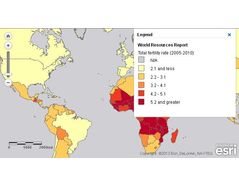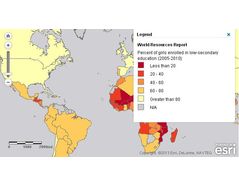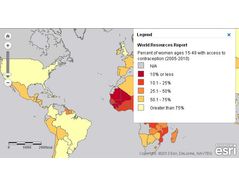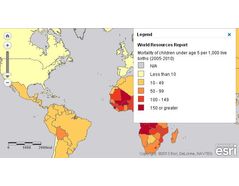
3 Unexpected ways to improve food security in Sub-Saharan Africa
The United Nations’ new population growth projections show that the world is set to reach nearly 9.6 billion by 2050. This growth holds serious implications for global food security. Absent other effective measures to control dietary shifts and reduce food loss and waste, the world will need to produce about 70 percent more food annually by 2050 to meet global demands. That is a big task, and even harder to do without converting millions more hectares of forests into farmland, contributing to climate change.
This challenge is particularly poignant in Sub-Saharan Africa.
The region’s population is on course to more than double from its current 0.9 billion by 2050 and quadruple to 3.9 billion people by 2100. Yet, according to the U.N. Food and Agriculture Organization (FAO), more than a quarter of Sub-Saharan Africa’s people are currently undernourished, and the region already imports roughly 20 percent of its staple calories. The region would need to increase crop production by 260 percent by 2050 in order to feed its projected population. Yet Sub-Saharan Africa has the world’s lowest grain yields and extensive areas of degraded soils.
One way to help meet the food challenge would be to hold down population growth. WRI’s new working paper, Achieving Replacement Level Fertility, finds that the region can match the rest of the world’s fertility rates through approaches that empower women, improve quality of life, and save millions of lives.
A Challenge in Sub-Saharan Africa
Most of the world’s regions have already achieved or are close to replacement level fertility, the rate at which a population exactly replaces itself from one generation to the next. Sub-Saharan Africa is the exception. Its total fertility rate was 5.4 children per woman during the 2005-2010 period―double the fertility rate of any other region. While the regional fertility rate is projected to decline to 3.2 by 2050, this will still result in a population increase of 1.2 billion people in Sub-Saharan Africa from 2012 to 2050.
Why do fertility rates remain so high in Sub-Saharan Africa? And what strategies can help nations achieve replacement level fertility? The interactive maps below point to answers to both of these questions.
- Increase educational opportunities for girls. In general, the longer girls stay in school, the later they start bearing children, and the fewer children they ultimately have. In most countries with total fertility rates of 2.1 children per woman or fewer (Map 1), between 80 to 100 percent of women of childbearing age have attained at least a lower secondary education level―that is, some high school (Map 2). But as Maps 1 and 2 show, Sub-Saharan Africa illustrates this relationship in reverse. The region has a low share of women with lower secondary education, but a large share of high birth rates.
- Increase access to reproductive health services, including family planning. Access to family planning counseling and technology ensures that women and men can make informed choices about reproduction. Millions of women want to space and limit their births, but do not have adequate access to reproductive health services. The World Health Organization (WHO) found that 53 percent of women in Africa who wish to control their fertility lack access to birth control, compared with 21–22 percent in Asia and Latin America. Studies also show that Sub-Saharan Africa has the lowest share of women who use contraception (Map 3).
- Reduce infant and child mortality. Reducing infant and child mortality assures parents that they do not need to conceive a high number of children in order to assure survival of a desired number. Reducing infant and child mortality comes from better health care, sanitation, and food. On average, countries with low fertility rates have low infant and child mortality rates. Once again, Sub-Saharan Africa illustrates this relationship in reverse (Map 4).




Botswana’s experience showcases the impact of reducing child mortality and increasing access to family planning and education. A country-wide, free system of health facilities that integrates maternal and child healthcare, family planning, and HIV/AIDS services has played an important role in controlling population growth. Mortality rates for children under five declined from 81 per 1,000 in 2000 to 26 per 1,000 in 2011. Contraceptive use increased from 28 percent in 1984 to 53 percent in 2007. Botswana has long provided free education to all, and still exempts the poorest from school fees, resulting in an 85 percent literacy rate and a rate of 88 percent of girls enrolled in lower secondary education. The result: In 1981, the average woman in Botswana gave birth to 6.1 children. By 2010, that rate had fallen to 2.8.
Food Security, Economic, and Environmental Benefits
These approaches have intrinsic benefits because they advance gender equity, give people more control over life decisions, and save millions of lives. They also offer benefits when it comes to food security, economic development, and the environment. For example:
- Achieving replacement level fertility in the region (and therefore the world as a whole) would reduce global food demand by 600 trillion kilocalories (kcal) per year by mid-century, closing about 9 percent of the gap between food available in 2006 and the amount needed in 2050. More dramatically, it would reduce the projected growth in food demand in Sub-Saharan Africa by one quarter between 2006 and 2050.
- Achieving replacement level fertility could lead to economic benefits through a “demographic dividend.” During and after a rapid decline in fertility, a country simultaneously has fewer children to care for and a greater share of its population in the most economically productive age bracket. Researchers estimate that this type of demographic shift was responsible for up to one third of the economic growth of the East Asian “Tigers” between 1965 and 1990.
- Achieving replacement level fertility would reduce agriculture’s impact on the environment. Based on FAO projections for yield gains in the region, Sub-Saharan Africa will need to add more than 125 million hectares of cropland from 2006 levels to meet the region’s projected food needs in 2050. Achieving replacement level fertility would cut that needed cropland expansion in half, sparing from conversion an area of forest and savannah equivalent to the size of Germany.
Ensuring that girls get an education, that families have access to health services, and that childhood mortality declines may not be commonly thought of as approaches for achieving food security. But they are effective—and they’re a critical part of achieving a sustainable food future.
LEARN MORE: Download our full working paper, Achieving Replacement Level Fertility
-
Most popular related searches
Customer comments
No comments were found for 3 Unexpected ways to improve food security in Sub-Saharan Africa. Be the first to comment!
